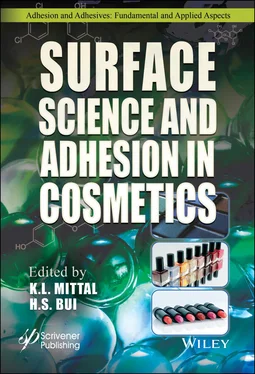Figure 1.9demonstrates the results from the kiss test by a sensory panel. In this study, lipstick was applied to a consumer panel in order to confirm the lastingness of the lipstick being investigated; after drying, four prints were made on a piece of white paper [58]. As seen in Figure 1.9, Formulation A had a much larger transfer amount compared to Formulations B and C; therefore, one could conclude that Formulation A is not as transfer-resistant.
Such studies help identify key differences between formulations and the impact these components have on durability, transfer, and lastingness. For example, the study above indicates the impact that the wax, butter, and copolymer type have on performance [58]. Not only does this information help formulators further optimize their compositions, but it also helps in regards to comparisons with competitor products. This method is a relatively quick and efficient way to help identify transfer in ideal conditions, without the influence of water or oil.
1.3.3.2 Gloss Measurement
Currently, most single-step long-wear lipsticks have a matte finish simply due to formulation components, but fashion and beauty trends may result in the consumer desiring other options for lipstick appearance; for example, some view glossy lips as an indication of health or youthfulness. During the formulation process, the level of gloss can be measured using a glossmeter, which measures the reflection from a surface by shooting a beam of light (the incident light) at a specified angle. The reflected light is then measured and the ratio of reflected light to incident light is taken as a measure of gloss.
In using this meter, the formulation is spread between fifty to five hundred micrometers in thickness on either a Leneta contrast card or BYK Opacity Chart and left to dry for twenty-four hours at room temperature [4]. Once dry, the sample is measured at 60° on a white background using a BYK Gardner glossmeter [4]. This measurement is conducted three times and averaged. In the event that the measured value obtained at 60° is too large, therefore meaning the sample is very glossy, the angle is adjusted to 20° in order to allow for an accurate reading. This analysis can also be completed after the application of olive oil or saliva to determine the impact on formulation appearance.

Figure 1.9 Comparison of 3 lipsticks demonstrating high formulation transfer (A) and low formulation transfer (C). Each panelist kissed the white paper four consecutive times without reapplication, as seen through prints 1-4 [58].
1.4 Relation of In Vitro Analysis with Consumer Sensory Testing
Sensory tests are commonly used in a wide variety of fields, especially in the cosmetics field, in order to gain a better understanding as to the product’s performance and perception made by the consumer. In doing so, the product under development can be further improved and optimized whilst being compared to similar competitor products. Sensory testing can be conducted in three different methods: discriminative, affective, or descriptive [58]. Discriminative testing is typically used to screen for a detectable difference between two products, whether of the same brand or that of a competitor. Affective testing determines the consumer’s acceptance or preference towards a particular product. Descriptive testing provides more detail in regards to characteristics of a product. While each of these methods provides useful information to formulators, each is restricted in terms of information provided or ease of analysis.
Currently, there is limited information available relating data obtained from the in vitro characterization of lipsticks directly to that observed during consumer sensory tests. Typically, products are evaluated and then passed on for consumer testing. These tests aim to target specific characteristics of the formulation which may correlate with quantitative measurements made in a laboratory setting. While this is useful for relating the quantitative characteristics described by consumers, it does not quite indicate if the product will perform well in terms of the consumer actually liking the product. Consumer sensory tests are also restricted in the sense that only three to four formulations can be tested at a time due to the limited availability of panelists, time restrictions, and cost; therefore, it is imperative that the best rated lipsticks in laboratory screenings are selected.
The sensory evaluation is typically conducted in a controlled environment, where the temperature, humidity, and lighting can be regulated. Panels may be untrained or trained, depending on the scope of the study being carried out. A reliable sensory panel is necessary when investigating in order to allow for study reproducibility and consistency. Typically, this can be achieved by establishing an agreement between panelists regarding terms, definitions, and characteristic descriptions prior to product use; this allows for members of the panel to be consistent with their grading and ensures that each panel is analyzing fairly. A new approach for enhancing panel reliability has been described by Latreille et al.; this utilizes a mixed linear model which tests the panel’s reliability through various criteria [62]. This model measures both an individual’s reliability in addition to the group as a whole by looking at discrimination ability, repeatability, and agreement/disagreement using contrasts [62]. Though this method provides an accurate representation as to the panel’s reliability and reproducibility, it is restricted in the sense that it only works well for small panel groups with few products to evaluate; this is because as more products are added, results become much more complex [62]. Larger panels with more products are recommended to use other means to evaluate panel performance in relation to consistency of descriptors between products [62]. In short, it is imperative to be able to obtain repeatable and dependable results from such in vitro studies, as these help shape the evolution of a product’s formulation. These results also help scientists in translating findings from in vitro tests to product performance in panels, thus making it even more imperative that the findings are accurate.
In order to properly assign scores to lipstick products, studies typically include multiple sessions that help users precisely define key characteristics and develop sensory language to prevent any misinterpretations. For example, a study conducted by Yap and Aminah conducted five separate sessions with the panelists; these are shown in Table 1.2[63].
These panels are typically controlled in a few different aspects, the first being the environment in which the test is being conducted. Secondly, the desired key outcomes or findings are used to shape panelist questions and discussion points. For example, a panel of 50 lipstick users was used to compare transfer-resistant lipstick formulations with that of the user’s regular lipstick through two different tests [64]. The first test evaluated the transfer of the lipstick 30 minutes after application; panelists patted their lips with a white cloth and were asked if an acceptable amount was removed from the process, where 98% said yes [64]. Panelists were also asked if the amount was significant (to which 94% stated insignificant) and asked to compare to regular lipsticks (to which 92% stated the amount was less) [64]. The second test followed the same suit as the prior one, but after the 30-minute drying period, panelists were asked to drink water. 100% stated an acceptable amount stayed on the lips, where 98% said the amount removed was insignificant and 96% claimed the amount removed was less than regular lipstick [64].
Читать дальше













